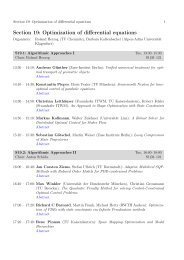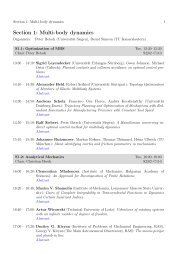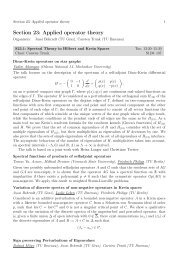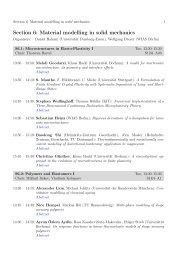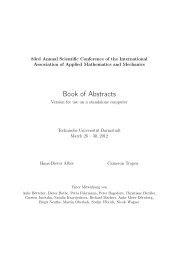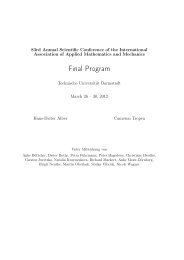Section 6: Material modelling in solid mechanics - GAMM 2012
Section 6: Material modelling in solid mechanics - GAMM 2012
Section 6: Material modelling in solid mechanics - GAMM 2012
You also want an ePaper? Increase the reach of your titles
YUMPU automatically turns print PDFs into web optimized ePapers that Google loves.
<strong>Section</strong> 6: <strong>Material</strong> <strong>modell<strong>in</strong>g</strong> <strong>in</strong> <strong>solid</strong> <strong>mechanics</strong> 13<br />
Heat treatment is an <strong>in</strong>dispensable part of the manufactur<strong>in</strong>g of metallic products, especially <strong>in</strong><br />
powder coat<strong>in</strong>g process. It provides an efficient way to manipulate the properties of the metal as<br />
e.g. hardness, yield stress and tensile stress by controll<strong>in</strong>g the rate of diffusion and the rate of<br />
cool<strong>in</strong>g with<strong>in</strong> the microstructure.<br />
The process-<strong>in</strong>tegrated powder coat<strong>in</strong>g by radial axial roll<strong>in</strong>g of r<strong>in</strong>gs is a new hybrid production<br />
technique which is <strong>in</strong>troduced <strong>in</strong> [1]. It takes advantage of the high temperatures and high<br />
forces of the r<strong>in</strong>g roll<strong>in</strong>g process not only to <strong>in</strong>crease the r<strong>in</strong>gs diameter, but also to <strong>in</strong>tegrate<br />
the application and compaction of powder metallurgical multi-functional coat<strong>in</strong>gs to the <strong>solid</strong><br />
substrate r<strong>in</strong>gs with<strong>in</strong> the same process [2]. The applied temperatures <strong>in</strong> hot roll<strong>in</strong>g are with<strong>in</strong><br />
the range of austenitiz<strong>in</strong>g temperatures for the <strong>in</strong>vestigated steels. Therefore, controlled cool<strong>in</strong>g<br />
can be conducted directly from process heat subsequent to the deformation process.<br />
The talk is concerned with the f<strong>in</strong>ite element (FE) simulation of the process-<strong>in</strong>tegrated powder<br />
coat<strong>in</strong>g by radial axial roll<strong>in</strong>g of r<strong>in</strong>gs and the <strong>in</strong>tegration of heat treatment of the rolled r<strong>in</strong>g<br />
<strong>in</strong>to the subsequent cool<strong>in</strong>g process. F<strong>in</strong>ally parameter studies are performed to analyse the<br />
temperature profile and phase transformation <strong>in</strong> the r<strong>in</strong>gs cross-section.<br />
[1] J. Frischkorn, S. Reese, Modell<strong>in</strong>g and Simulation of Process-<strong>in</strong>tegrated Powder Coat<strong>in</strong>g by<br />
Radial Axial Roll<strong>in</strong>g of R<strong>in</strong>gs, Archive of Applied Mechanics 81 (2011)<br />
[2] R. Kebriaei, J. Frischkorn, S. Reese, Influence of Geometric Parameters on Residual Porosity<br />
<strong>in</strong> Process-<strong>in</strong>tegrated Powder Coat<strong>in</strong>g by Radial Axial Roll<strong>in</strong>g of R<strong>in</strong>gs, Steel Research<br />
International 163 (2011)<br />
Simulation of phase-transformations based on numerical m<strong>in</strong>imization of <strong>in</strong>tersect<strong>in</strong>g<br />
Gibbs energy potentials<br />
Richard Ostwald, Thorsten Bartel (TU Dortmund), Andreas Menzel (U Dortmund / Lund University)<br />
We present a novel approach for the simulation of <strong>solid</strong> to <strong>solid</strong> phase-transformations <strong>in</strong> polycrystall<strong>in</strong>e<br />
materials. To facilitate the utilization of a non-aff<strong>in</strong>e micro-sphere formulation with<br />
volumetric-deviatoric split, we <strong>in</strong>troduce Helmholtz free energy functions depend<strong>in</strong>g on volumetric<br />
and deviatoric stra<strong>in</strong> measures for the underly<strong>in</strong>g scalar-valued phase-transformation model.<br />
As an extension of aff<strong>in</strong>e micro-sphere models [3], the non-aff<strong>in</strong>e micro-sphere formulation with<br />
volumetric-deviatoric split allows to capture different Young’s moduli and Poisson’s ratios on the<br />
macro-scale [1]. As a consequence, the temperature-dependent free energy assigned to each <strong>in</strong>dividual<br />
phase takes the form of an elliptic paraboloid <strong>in</strong> volumetric-deviatoric stra<strong>in</strong> space, where<br />
the energy landscape of the overall material is obta<strong>in</strong>ed from the contributions of the <strong>in</strong>dividual<br />
constituents.<br />
For the evolution of volume fractions, we use an approach based on statistical physics—tak<strong>in</strong>g<br />
<strong>in</strong>to account actual Gibbs energy barriers and transformation probabilities [2]. The computation<br />
of <strong>in</strong>dividual energy barriers between the phases considered is enabled by numerical m<strong>in</strong>imization<br />
of parametric <strong>in</strong>tersection curves of elliptic Gibbs energy paraboloids. The framework provided<br />
facilitates to take <strong>in</strong>to account an arbitrary number of <strong>solid</strong> phases of the underly<strong>in</strong>g material,<br />
though we restrict ourselves to the simulation of three phases, namely an austenitic parent phase<br />
and a martensitic tension and compression phase. It is shown that the model presented nicely<br />
reflects the temperature-dependent effects of pseudo-elasticity and pseudo-plasticity, and thus<br />
captures experimentally observed behaviour at different temperatures.



